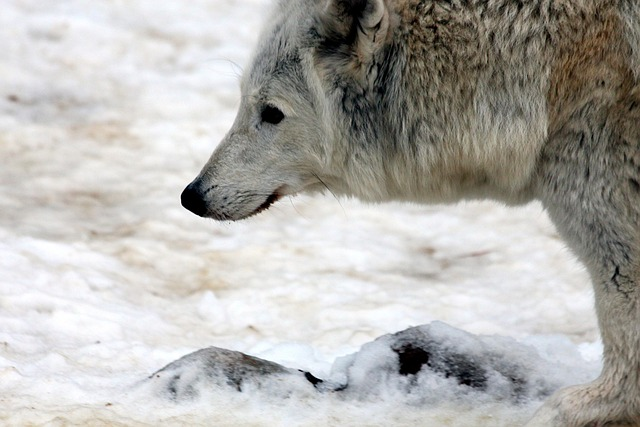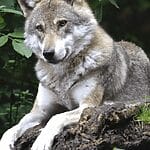Wolves have always captured our imagination, roaming the wild landscapes as symbols of mystery and strength. But among them, the biggest wolves hold a particular fascination. Who wouldn’t want to know more about the largest wolf ever recorded?
This rare giant, known for its incredible size and strength, has been a topic of both awe and curiosity. Many wonder how large it really was and how it compares to other wolf species around the world.
In this article, we’ll explore the history of the biggest wolf ever recorded. We’ll explore not just its size and characteristics but also its impact on ecosystems and human perceptions.
Top 7 of The Largest Wolves Species in The World
Alaskan Interior Wolf – (Canis lupus pambasileus)
The Alaskan Interior Wolf is the second largest subspecies of the gray wolf in the world and can weigh up to 120 pounds. The scientific name of the Alaskan or Yukon wolf is Canis lupus pambasileus. Found in the northern forests, alpine and subalpine regions, and the Arctic tundra of the Alaskan wilderness.

This subspecies of gray wolf typically measures more than 6 feet long from nose to tail. These wolf species have adapted to the harsh environment by developing thicker fur and larger body size.
These wild wolves, also known as Yukon wolves, are generally blackish to white with some tan and gray. They are mainly found in Canada and Alaska.
The Alaskan Wolf plays an important role in maintaining the balance of the ecosystem, preying on large mammals such as moose and caribou.
As one of the most endangered species in North America, it’s important to protect the Alaskan Interior Wolf.
However, the population of the Alaskan wolf is yet maintained as around five thousand wolves are living in the Yukon territory.
Great Plains Wolf – (Canis lupus nubilus)
The Great Plains Wolf (Canis lupus nubilus) is the biggest wolf species native to the united states and Canada. It has a thick coat that ranges from black and white.
The Great Plains Wolf and Alaskan wolf have similar sizes and can weigh up to 110 pounds. It is an expert hunter that uses stealth, speed, and agility when chasing prey such as deer, elk, sheep, and other small animals.
Moreover, the Great Plains Wolves are highly social animals with a complex communication system involving vocalizations, scent marking, and body language.
Tundra Wolf – (Canis lupus albus)
The Tundra Wolf (Canis lupus albus) is also known as the Arctic Wolf, White Wolf, or Polar Wolf due to its white coat of fur.
It generally lives in areas with snow-covered tundra and subarctic regions of Northern Canada, Alaska, and Greenland. The Tundra Wolf is mainly carnivorous and has a diet consisting of large mammals such as caribou, muskoxen, Arctic hares, lemmings, and ground squirrels.
Additionally, the average weight of a male tundra wolf is around 108 lb and a female weighs nearly 90 lb, and are medium-sized wolves. But the giant tundra wolves weigh around 115 lb and differ in length from 3.5 to 4.5.
Its light grey fur helps them to blend in the snow, making it an efficient hunter in its natural environment.
Northern Rocky Mountain Wolf
The Northern Rocky Mountain Wolf (Canis lupus irremotus) is the largest subspecies in the world. It has a flat, narrow nose pad, and its fur is usually gray or black.

They typically inhabit rocky mountains and forests in northern North America, from western Canada to Montana and Wyoming.
Moreover, the Northern Rocky Mountain Wolves can range from 70 to 150 lbs and have fur in grey or black with more white.
They commonly hunt in packs with three to six members and consume various animals, including deer, elk, moose, small mammals, and fish.
The Northern Rocky Mountain Wolf is an important species for maintaining the balance of nature in its habitat. Conservation efforts have helped their population back to healthy levels after a steady decline in the early 1900s.
Mackenzie Valley Wolf – (Canis Lupus Occidentalis)
The Mackenzie Valley Wolf (Canis Lupus Occidentalis) is one of the biggest wolves found in North America. It’s other names include Alaskan timber wolf and Canadian timber wolf.

The male wolf of this subspecies weighs around 137 lb, and a female weighs nearly 101 lb with length reaching up to 32 inches. That makes it one of the largest wolves in the world. With this, one wolf of this species reached up to the record-breaking weight of 175 lb.
They’re also known for their thick winter coats and large paws that help them traverse deep snow and icy terrain. These wolves are mainly found in northern Canada and Alaska.
Despite this, there are still conservation efforts going on to protect them and lessen the chances of their extinction.
These predatory animals hunt large mammals like moose, elk, and deer. They are known as a powerful hunter with fast running speeds reaching up to 60 km/h.
They are an essential part of its native ecosystem and play an important role in maintaining the balance of its habitat.
Steppe Wolf (Caspian Sea Wolf)
The stepper wolf or Caspian sea wolf got its name from the steppes of Eurasia, which is its native subspecies. It is one of the biggest wolf species with a weight of around 88 lb and is 6.6 feet long, but not huge like Eurasian wolves, their closest cousins.

Additionally, their coat is rusty grey in color with black tips on their ears and tail. This wolf lives in Russia, Kazakhstan, and China, making its home in the Caucasus or steppes near the Caspian Sea. Moreover, they hunt during dusk and dawn, feeding on small mammals like rabbits, hares, and Caspian seals.
They live near the human population and attack livestock whenever they get the chance. This species is at risk due to constant killing by the shepherds, which is why the IUNC classified them as endangered.
Eurasian Wolf – (Canis lupus lupus)
The Eurasian Wolf (Canis lupus lupus) is believed to be the biggest wolf species in existence and can be found throughout Europe, northern Africa, and western Asia.

The Eurasian Wolf males are up to 160 cm in length and weigh as much as 175 pounds. Moreover, when it comes to appearance, this species typically has thick grey-brown fur, a broad head, and a wide muzzle.
Behaviorally, the Eurasian Wolf is known for being extremely social and highly territorial. They are pack animals that work together to hunt and protect their young from predators.
Do wolves attack humans?
Yes, but it’s very rare. Wolves in the wild rarely see humans and therefore don’t view them as prey or a threat. Attacks are more likely to occur when a wolf’s natural habitat has been encroached upon by people, such as hunting grounds.
In such a scenario, a wolf may become emboldened and view humans as potential prey or a threat they need to defend against.
Conclusion
There are around 200,000 to 250,000 wolf species in the world. And the most common species is the grey wolf which has an average weight of 80 kg and is three to five feet long.
Besides it, many other subspecies of the wolf are impressively large in size and heavy weight, such as the Alaskan interior wolf, great plains wolf, tundra wolf, and Steppe wolf.
These largest wolves are listed as the world’s biggest wolves not just because of their size and weight but also due to their appearance and other characteristics.
You can check out the video below to explore the biggest wolves in the world.
Frequently Asked Questions
Where Do Wolves Live?
Wolves are found across various global landscapes, from the tundra to deserts. They inhabit forests, grasslands, and mountain regions in North America, Eurasia, and parts of India and China. Despite their broad range, human activities have significantly limited their habitats, mostly confining them to remote wilderness areas.
Can you buy a wolf as a pet?
It is illegal to have the pure breed of the wolf as a pet.
What is the biggest wolf in the world?
The largest wolf in the world is the Mackenzie Valley Wolf, also known as the Northwestern Wolf or Canadian Timber Wolf. This subspecies is found in Alaska and Western Canada, with an estimated population of 7,000 to 10,000 individuals.
How Big Are Wolves?
On average, a wolf can be three to five feet long, but there are many other species that are bigger than this.
What is the largest wolf in history?
The largest wolf in history is the Dire Wolf (Canis dirus), which was one of the largest canines to have ever existed. Although it was not as large as depicted in fantasy films and video games, the Dire Wolf was an impressive predator during the Pleistocene Epoch, approximately 125,000 to 10,000 years ago.
What is the biggest wolf’s height?
The northwestern wolf is the tallest wolf with a height of up to 7 feet.
How big is a dire wolf?
The largest wolf in history is the Dire Wolf (Canis dirus), which lived during the Pleistocene Epoch, approximately 125,000 to 10,000 years ago. It was a formidable predator, measuring almost five feet from head to tail and weighing in the vicinity of 150 to 200 pounds.
- What Should I Do If A Koala Bites Me? Safety Guide - 2024-05-30
- Are Kangaroos Born Without Hind Legs? A Fascinating Journey - 2024-05-30
- Animals That Look Like Squirrels - 2024-05-30








